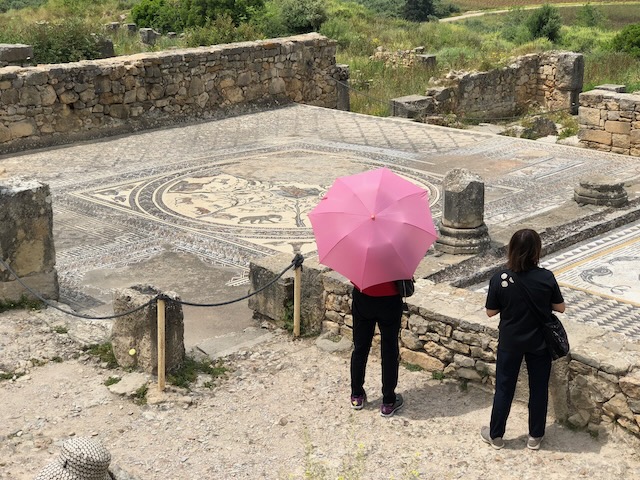
Driving through Morocco between Fez and Rabat, the last thing I had expected to come across was very well-preserved Roman ruins. And yet, out the window of our car we spotted marble columns amidst the weeds. Our guide wanted us to see the ruins of Volubilis – dating from the 1st century B.C. I had not realized the extent of the Roman civilization – which encompassed all of north Africa.
These ruins are a must-see if you are in Morocco. That is because the floor mosaics are some of the best preserved specimens of Roman mosaics anywhere in the world, and because without some serious levels of care, they will disappear in the coming years. Even though this site is a UNESCO World Heritage Site, they are not protected from the elements. So go see them quickly.
In its heyday of 100BC-200AD Volubilis was a major trading center, as it was located along the trade routes crossing North Africa. Being a center of trade, the people became very wealthy and built lavish homes and public buildings. Today, the site is still be excavated. In a field of wildflowers and weeds, the foundations of dozens of homes have been uncovered exposing the floor mosaics. Unlike Pompeii, where volcanic ash entombed the city leaving it unchanged since 79 AD, here the buildings succumbed to the rages of time – walls crumbled, and dirt covering them up. But the floors remained almost untouched!

We loved the authentic feel to the ruins. It was devoid of tourists. Storks (which you can see in the picture below) roosted on the columns. Some buildings and walls have been reconstructed, but the real attraction are the mosaics.

In the open air, you can walk down what were streets of old, with buildings on each side. Partial walls outline the foundation of the buildings and leave the floors very visible. Ropes cordon off the areas you are not supposed to walk – but you still can get up-close-and-personal with each mosaic.
The intricacies are amazing. It would be difficult today to have these floors reproduced in your home. Yet here, 2000 years ago, artisans spent what must have been months laying these artworks. And they look like they were just laid yesterday.

Many of the mosaics are geometric patterns – but using very small tiles so the patterns can be very complicated.

Each mosaic is different from the rest. There doesn’t appear to be any common theme. Some depict mythological creatures, while others show scenes from daily life. It must have been up to the owner of house. But also, the shear quantity of mosaics all displaying excellent craftsmanship, means that there was a large group of talented artisans in the area.




Now is the best time to visit Morocco and to see something which might vanish in the coming years. And make sure to add a day-trip out of Fez to see Volubilis. You will not regret it.
For other things to do in Morocco see our Argan Oil travelogue.







